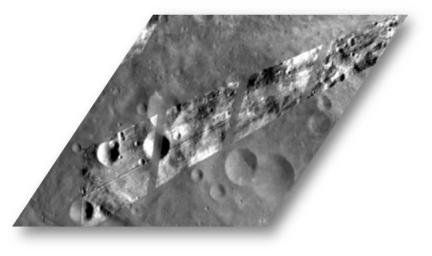
|
Small-scale Surface Variations Seen with Dawn’s Visible and Infrared Spectrometer
- Click the image above for a larger view
- Full-Res JPEG (647 x 383) (22.0 kB)
- Full-Res TIFF (647 x 383) (248.3 kB)
Caption:
This image shows a Dawn VIR (visible and infrared spectrometer) image, overlain on top of a FC (framing camera) image of the same region. The VIR image was acquired during the HAMO (high-altitude mapping orbit) phase of the Dawn mission and the FC image was acquired during the Survey phase of the mission. The small-scale brightness and darkness variations in this image demonstrate VIR's ability to detect small-scale features on Vesta's surface. The composition of these various features can then be analyzed. VIR data have shown that, in general, Vesta has a basaltic surface and that two prominent pyroxene absorption bands dominate Vesta's spectrum.
This image is located in Vesta's Tuccia quadrangle and the center of the image is 21 degrees south latitude, 200 degrees east longitude. NASA's Dawn spacecraft obtained the VIR image with its visible and infrared spectrometer on Oct. 02, 2011. The distance to the surface of Vesta is around 700 kilometers (435 miles) and the average image resolution is 170 meters per pixel.
Background Info:
The Dawn mission to Vesta and Ceres is managed by NASA's Jet Propulsion Laboratory, a division of the California Institute of Technology in Pasadena, for NASA's Science Mission Directorate, Washington D.C. UCLA is responsible for overall Dawn mission science. The visible and infrared mapping spectrometer was provided by the Italian Space Agency and is managed by the Italy's National Institute for Astrophysics, Rome, in collaboration with Selex Galileo, where it was built. The Dawn framing cameras have been developed and built under the leadership of the Max Planck Institute for Solar System Research, Katlenburg-Lindau, Germany, with significant contributions by DLR German Aerospace Center, Institute of Planetary Research, Berlin, and in coordination with the Institute of Computer and Communication Network Engineering, Braunschweig. The Framing Camera project is funded by the Max Planck Society, DLR, and NASA/JPL.
More information about the Dawn mission is online at http://www.nasa.gov/dawn and http://dawn.jpl.nasa.gov .
Cataloging Keywords:
| Name | Value | Additional Values |
|---|---|---|
| Target | 4 Vesta | |
| System | Main Belt | |
| Target Type | Asteroid | |
| Mission | Dawn | |
| Instrument Host | Dawn | |
| Host Type | Orbiter | |
| Instrument | Framing Camera (FC) | Visible and Infrared Spectrometer (VIR) |
| Detector | ||
| Extra Keywords | Grayscale, Infrared | |
| Acquisition Date | ||
| Release Date | 2012-02-07 | |
| Date in Caption | 2011-10-02 | |
| Image Credit | NASA/JPL-Caltech/UCLA/MPS/DLR/IDA | |
| Source | photojournal.jpl.nasa.gov/catalog/PIA15342 | |
| Identifier | PIA15342 | |
